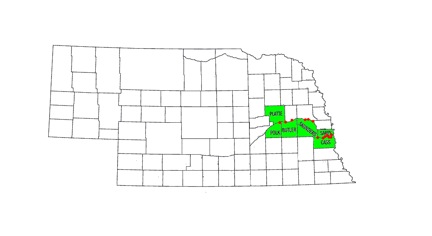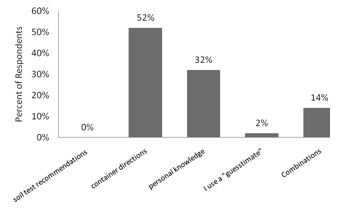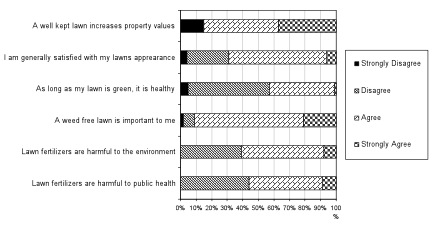 |
April 2010
|
April 2010 // Volume 48 // Number 2 // Research In Brief // v48-2rb4
Lawn Management Practices and Perceptions of Residents in 14 Sandpit Lakes of Nebraska
Abstract
The sandpit lakes of eastern Nebraska have become an area of concern due to toxic algae blooms and associated water quality problems. During the spring of 2006, surveys were distributed to residents of 14 sandpit lake communities throughout Nebraska in order to generate information on lawn management practices, perceptions and attitudes. The survey was used to provide insight to current residential lawn care practices. The majority of respondents fertilize their lawn at least once each year. However, because only 3% of respondents have ever had their soil tested, education effort should focus on proper lawn management (particularly fertilization) practices.
Introduction
As the population continues to increase in urban and peri-urban residential areas, the extent and intensity of lawn care and associated use of consumables, including fertilizers and pesticides, is expected to increase (Balogh, Gibeault, Walker, McKenna, & Snow, 1992, p 5-7; Anonymous, 2006). In the United States, 74% of households use some form of manufactured fertilizers or pesticides (Robbins, Polderman, & Birkenholtz, 2001). Rates of application vary, but nitrogen application rates for lawns have been found to be comparable to rates for crop production and golf courses, and these rates are increasing in urban watersheds (Gold, DeRagon, Sullivan, & Lemunyon, 1990; Law, Band, & Grove, 2004).
Inappropriate use of lawn chemicals may have adverse effects on water quality, such as eutrophication (inputs of excessive nutrients to a body of water) and hypoxia (oxygen depletion of a water body resulting from rapid decomposition of organic material) (Balogh and Watson, 1992; King, Harmel, Torbert, & Balogh, 2001). Lawn care professionals may feel limited in their flexibility to recommend lower-input management approaches, in part because of customers' attitudes (Ingram, Stier, & Bird, 2008).
Sandpit lakes in Nebraska, many adjacent to the Platte River with surface areas of 0.2 ha (0.5 A) to 80 ha (200 A), were originally excavations for construction sand. There are over 800 publicly and privately owned sandpit lakes in Nebraska. Many of these lakes have been developed for recreational uses such as boating and fishing, and for either weekend or full-time residences. However, in recent years the waters of many sandpit lakes have been degraded due to nutrient loading leading to eutrophication and the development of toxic algae blooms. One possible source of excess nutrients, particularly phosphorus (P), may be residential lawns bordering the lakes. Other possible P sources are single home septic systems, fertilizer use from agricultural land, and water fowl. Since the soils bordering these lakes are coarse-textured and the lakes themselves are relatively shallow, the risk of nutrient loading is increased. Many of the lawns on homesites surrounding these lakes are routinely watered and fertilized, possibly to excess.
It is important to understand the attitudes and perceptions of homeowners when attempting to interpret the link between lawn care and water quality, and then to plan effective educational programming. The objective of the study reported here was to assess homeowner lawn management practices, and perceptions and attitudes toward environmental and public health issues by conducting a survey of residents of sandpit lake communities in eastern Nebraska. This information can be used by various agencies, managers, and Extension personnel to develop programs to enable residential landowners to implement more effective and environmental friendly lawn care practices.
Survey Methodology
Study Site Description
Potential survey recipients were identified using the Nebraska Lakes Association <http://www.nebraskalakes.org>, along with contacts provided by Tadd Barrow (Water Quality Extension Specialist, University of Nebraska-Lincoln). Surveys were distributed to residents of sandpit lake communities throughout eastern Nebraska during the spring of 2006. Locations with formal association leadership were chosen for the survey because they are among the most intensively developed recreational and residential lakes and so were expected to have sustained the greatest impact from land use management. Most surveys were distributed to lake communities in the Lower Platte River watershed, with the remainder in the central Platte or lower Elkhorn River watersheds (Figure 1).
Figure 1.
Location of Surveys Distributed
to Residents of Sandpit Lake Communities in Eastern
Nebraska. Dots Indicate Communities with Survey Respondents

Survey Design and Methods
For the purpose of the survey, "lawn" was defined as an area of land that is generally covered with grass and other plants that are maintained at an even, low height (< 7.5 cm [(3 in]).
The survey consisted of 32 questions separated into three different sections:
- Lawn management: requested information regarding fertilization, irrigation, mowing regime, lawn size, turfgrass type, and previous soil nutrient analyses.
- Lawn care attitudes and environmental perceptions: addressed questions regarding personal preference towards lawn aesthetics and management, and environmental perceptions.
- Septic systems: requested information regarding whether the home was served by a septic system, what was the system's age, and the system's history of maintenance and inspection.
Survey Distribution
Surveys were distributed to 130 residents of 14 sandpit lake communities. Surveys were sent in groups of 10 to a lake association contact, who then distributed the surveys to other residents. Additional surveys were sent out upon request. A cover letter explaining the study and return pre-paid envelopes were sent along with the survey.
Survey distribution was not random. First, not all homeowners had lawns as defined in the survey. Many lots were covered with sand from the house to the lakeshore. Consequently, surveys were distributed only to those residents who had lawn areas covered with grass. Second, additional surveys were distributed door to door while performing site evaluations.
Statistical Analysis
In order to analyze survey data, word responses from the survey were coded 1 to 4, where "1" corresponded to a low-impact practice (e.g., low fertilization rate). For analysis, questions and responses were arranged into four categories: management, environmental impact, aesthetics, and environmental attitude. Differences within each category by lake community were analyzed using the General Linear Model Procedure of SAS Version 9.1 (SAS Institute, 2003).
Results and Discussion
Response Rate
Of the surveys distributed to the survey population, 68 households responded, giving a response rate of 52%.
Lawn Management
Size and Type of Lawn
The mean size of the lawns surveyed was approximately 1010 m2 (¼ acre) or less. Of those surveyed, 67% had a lawn comprised of either Kentucky bluegrass (Poa pretensis L.) or turf-type tall fescue (Festuca arundinacea Schreb.). Kentucky bluegrass is a common turfgrass in eastern Nebraska because it has exceptional reproductive capacity and recovery. Turf type fescues are also commonly found in this region because of their tolerance to shade and their range of adaptability from temperate humid to temperate arid regions (Christians, 2004).
Management Costs
Nationally, homeowners spend a total of approximately $27 billion per year to maintain their lawns either themselves or by hiring outside help (Center for Watershed Protection, 2000a). In Nebraska, over $300 million is spent per year on turfgrass maintenance (Christians, 2004). Over half of the homeowners surveyed spent more than $100 each year maintaining their lawns. This amount is consistent with that reported by Fech & Gaussoin (2006).
Fertilization
The survey found that in a typical summer, 91% of the residents apply fertilizers to their lawn; however, only 3% of those surveyed have ever had their soil tested. This is lower than the 20% rate reported by Osmond and Hardy (2004). Nearly 50% of residents surveyed applied fertilizers one to two times per year, and 32% applied three to four times per year, with spring and fall being the most common seasons for fertilization. For those who fertilized, 66% apply the fertilizer themselves; of that group, 52% follow the directions given on the container (Figure 2).
Figure 2.
Homeowners' Response to,
"If you apply the fertilizer yourself, how do you determine the
amount to be applied?"

Irrigation
Intensity of irrigation practices is directly related to the intensity of cultural, nutrient, and pest management on turfgrass systems and has been associated with nutrient leaching from lawns (Balogh & Watson, 1992, p 42; Schueler, 1995). Overall, 85% of the survey respondents watered their lawns one to four times a week, with mean application rates of approximately 1.3 cm (0.5 in) per application. By combining survey results describing irrigation frequency and irrigation amount, we estimate that respondents may be watering at a minimum of 0.5 cm per week to a maximum of 10 cm per week.
Mowing
The survey reported that 82% of homeowners mowed their lawns at least once per week in a typical summer. Overall, 57% of those surveyed left the clippings on the lawn after mowing. Leaving clippings will help meet nutrient requirements through mineralization of plant material (Center for Watershed Protection, 2000b; Dest, Albin, & Guillard, 1992).
Lawn Care Attitudes and Perception
The second part of the survey focused on lawn care attitudes and perceptions of the homeowners. This section consisted of 11 questions that could be divided into two subtopics: 1) personal preference and 2) environmental attitude.
Personal Preference
The personal preference section consisted of statements addressing how homeowners felt about their lawns. We found that 85% of respondents felt that a well-kept lawn increased property values. Ninety percent of the homeowners took pride in the appearance of their lawns, and 69% were generally satisfied with appearance of their lawns (Figure 3).
When asked if a weed-free lawn was important to them, 91% agreed or strongly agreed. It may be inferred that some homeowners use herbicides for weed control under circumstances in which the control measures may be ineffective or inadvisable.
Figure 3.
Homeowners' Responses to
Multiple Questions Addressing Personal Preference and Environmental
Attitude

Environmental Attitude
The environmental attitude portion of the survey addressed statements pertaining to the environment and public health. Homeowners provided no clear sentiment when asked if they agreed with the statement "As long as my lawn is green, it is healthy" (Figure 3). Of those surveyed, 57% disagreed or strongly disagreed that a green lawn means a healthy lawn, compared to the 43% who agreed or strongly agreed with the statement.
When asked about lawn pesticides, 77% of homeowners agreed that pesticides are harmful to the environment, and 64% felt that pesticides are harmful to public health. These responses suggest a dichotomy between the broad environmental attitudes of the survey population and the potential for herbicide use to maintain a weed-free lawn noted earlier. A lower percentage of homeowners (61%) felt that lawn fertilizers are harmful to the environment, and 56% agreed that lawn fertilizers were harmful to public health (Figure 3).
Septic Systems
Improperly maintained septic systems are a potential source of lake water contaminants. Homes at seven of the 14 lake communities surveyed are served by single-dwelling septic systems, corresponding to 25% of the total survey respondents. Most septic systems were 6 or more years old. Seventy-seven percent of the respondents agreed that inspection and routine clean-out of septic tanks is necessary to protect water quality. Thirty-five percent of respondents reported that their system was checked every 3 years or more frequently, but 41% did not know how often the septic system was inspected and emptied.
Statistical Analysis
Each grouped response category (management, environmental impact, aesthetics, and environmental attitude) was analyzed to determine if responses differed among residents of the different lake communities. It might be suspected that responses would vary among lakes due to social factors. For example, homeowners may feel compelled to maintain a certain aesthetic value of their lawns in one lake community, but feel less pressure at another. Also, some lake organizations might have specific rules and regulations towards the upkeep of the properties on the lakes. Despite this, there was no significant difference among residents grouped by lake community for any group of survey responses: Management (P =0.66), Environmental Impact (P = 0.33), Aesthetics (P = 0.47), and Environmental Attitude (P = 0.47).
Conclusions and Recommendations
The residential lawn care survey reported here is one of few studies that attempted to assess homeowner lawn management practices and attitudes, and the only study found focusing on Great Plains communities and sandpit lakes. Eighty-five percent of those surveyed felt that a well-kept lawn increases property values, and 90% take pride in the appearance of their lawn. This may lead some homeowners to over apply turfgrass chemicals in pursuit of a high-quality lawn.
The survey results suggest that attitudes are ambiguous toward the environment and public health. A majority of respondents fertilize their lawn at least once each year. This is a potential cause for concern if residents apply fertilizer regardless of whether additional nutrients, particularly P, are needed. This concern was also noted by Osmond and Hardy (2004).
Related to this is that only 3% of respondents have ever had their soil tested. As a partial remedy, some lake associations are recommending the use of N-only fertilizers. This is an appropriate recommendation because the average Bray and Kurtz 1 P analysis for a subset of lawn soils in the study was 97.3 mg P/kg soil (ppm) in the 0-11 cm (0.0-4.3 in) depth and 72.4 mg P/kg soil (ppm) in the 12-22 cm (4.7-8.7 in) depth. These values are in contrast to a Bray and Kurtz 1 P analysis of 24 to 30 mg P/kg soil (ppm) in excess of which plants generally do not respond.
In order to better accomplish the dual goals of high-quality home turf and maintenance of water quality in these sensitive sandpit lake communities, current effective education and outreach programs should be strengthened. The intent should be to inform residents of these communities about lawn management practices having low potential for negative environmental impact, emphasizing nutrient management. These educational efforts could be targeted and designed for direct delivery to homeowners or magnified and enhanced through delivery to Master Gardeners, lawn care operators, and county Extension personnel.
References
Anonymous. (2006). U.S. lawn and garden consumables demand to exceed $9 billion in 2010. Grounds Maintenance. 41(9), 10
Balogh, J. C., Gibeault, V. A., Walker, W.J ., Kenna, M. P.,& Snow, J. T. (1992). Background and overview of environmental issues. p 1-37. In. J.C. Balogh & W.J. Walker (eds.). Golf course management and construction: Environmental issues. Lewis Publishers. Baca Raton, Fl.
Balogh, J. C., & Watson, J. R., Jr. (1992). Role and conservation of water resources. p 39-104. In. J.C. Balogh & W.J. Walker (eds.). Golf course management and construction: Environmental issues. Lewis Publishers. Baca Raton, Fl.
Center for Watershed Protection. (2000a). Understanding watershed behavior. Watershed Protection Techniques. 3(3), 671-679.
Center for Watershed Protection. (2000b). Toward a low input lawn. Watershed Protection Techniques. 1(5), 254-264.
Christians, N. E. (2004). Fundamentals of turfgrass management. John Wiley & Sons, Inc., Hoboken, New Jersey.
Dest, W. M., Albin, S. C., & Guillard, K. (1992). Turfgrass clipping management. Rutgers turfgrass proceedings. 23,28-38.
Fech, J.C. & Gaussoin, R.. (2006). Selecting a lawn care company. University of Nebraska-Lincoln Extension, Institute of Agriculture and Natural Resources. April 2006: G1617.
Gold A. J., DeRagon, W. R., Sullivan, W. M., & Lemunyon, J. L. (1990). Nitrate-Nitrogen losses to groundwater from rural and suburban land uses. J. Soil Water Conserv. 45, 305-310.
Ingram, M., Stier, J., & Bird, E.. (2008). Relax! It's just a dandelion: Perceived benefits and barriers to urban integrated pest management. Journal of Extension [On-line], 46(1) Article 1FEA4. Available at: http://www.joe.org/joe/2008february/a4.php
King, K. W., Harmel, R. D., Torbert, H. A., & Balogh, J. C. (2001). Impact of a turfgrass system on nutrient loadings to surface water. J. Am. Water Res. Assoc. 37, 629-640.
Law, N. L., Band, L. E., & Grove, J. M. (2004). Nitrogen input from residential lawn care practices in suburban watersheds in Baltimore County, MD. J. Environ. Plan. & Mgmt. 4:737-755.
Osmond, D. L. & Hardy, D. H. (2004). Characterization of turf practices in five North Carolina communities. J. Environ. Qual. 33, 565-575.
Robbins, P., Polderman, A., & Birkenholtz, T. (2001). Lawns and Toxins: An Ecology of the City. Cities, 18(6), 369-380.
SAS Institute. (2003). SAS 9.1. SAS Institute, Cary, NC
Schueler, T. (1995). Nitrate leaching potential from lawns and turfgrass. Tech. Note 56. Watershed Protection Technol. 2 ,276-278.




